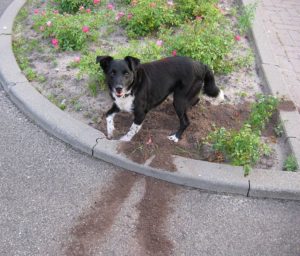 While some dogs will dig at any time of year, digging is a problem which typically becomes more prevalent in warmer weather and/or during rainy seasons. With many smells beneath the surface, temptations of scampering squirrels and chirping birds, and holes making a great cool place to lie, many dogs begin excavating their yards as the barometer rises.
While some dogs will dig at any time of year, digging is a problem which typically becomes more prevalent in warmer weather and/or during rainy seasons. With many smells beneath the surface, temptations of scampering squirrels and chirping birds, and holes making a great cool place to lie, many dogs begin excavating their yards as the barometer rises.
There are many down sides to having a digging dog. One is that when summoned, he’s likely to appear at your back door covered in dirt…. not a desirable condition!
Another concern is the expense of ruined flowers and bushes, or damage to your lawn.
Last but certainly not least, is the serious problem that if your dog is digging under your fence, a lost or injured pet could be the heartbreaking result.
Begin by working with your dog on obedience commands, outside in your yard. This will help make it clear that this is an area where rules are to be followed.
Add in your supervision whenever your pet is outdoors. While this may seem like a lot of work, a few weeks of chaperonage will pay off in years of a trustworthy pet. The goal of your vigilance is to catch your dog in the act of digging, and teach him a replacement behavior.
For example, if your dog digs holes because he likes to lie in them, you’ll need to catch him either digging or lying in there, correct him “No!”, and teach him a more appropriate place to stay cool. Use the down/stay to train your dog to relax under a shade tree or perhaps on a covered deck instead.
If your pet seems to be digging because he’s trying to ‘escape’, this can be more of a challenge. You’ll need to have your dog on a long lead and wait for him to start tunneling under the fence. When you catch him in the act, you’ll need to correct him “No!”, and replace with obedience commands, ball playing, or another appropriate activity.
The same technique can be used to teach your pet to stay out of flower beds, not to chew bushes, etc.
Be sure to fill in all holes right away. Dogs are more likely to continue an old hole than to begin a new one. Also do not allow food or prey items, such as rawhides, pig’s ears, real bones, or treats outdoors. Many dogs instinctively dig and bury those items, saving them for a later date.
With patient redirection, obedience training, and diligent supervision, your dog can soon follow the rules of your yard!






Leave a Reply
You must be logged in to post a comment.